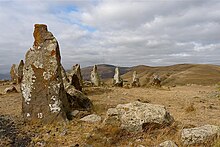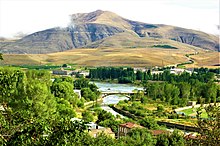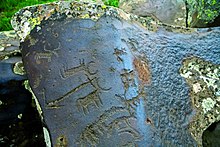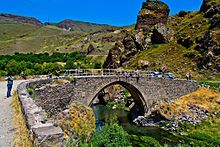Sisian
Sisian Սիսիան | |
|---|---|
Saint Gregory Church of 689 Sisian Town Hall General view of Sisian Sisian with Mt Mets Ishkhanasar | |
| Coordinates: 39°31′15″N 46°01′56″E / 39.52083°N 46.03222°E | |
| Country | |
| Province | Syunik |
| Municipality | Sisian |
| First mentioned | 8th century BC |
| Government | |
| • Mayor | Armen Hakobjanyan |
| Area | |
• Total | 9 km2 (3 sq mi) |
| Elevation | 1,600 m (5,200 ft) |
| Population | |
• Total | 13,179 |
| • Density | 1,500/km2 (3,800/sq mi) |
| Time zone | UTC+4 (AMT) |
| Area code | +374 2830 |
| Website | Official website |
Sisian (Armenian: Սիսիան [sisˈjɑn]) is a town and the centre of the Sisian Municipality of the Syunik Province in southern Armenia. It is located on both banks of the Vorotan River, at an altitude of 1600 m above sea level, 6 km south of the Yerevan-Meghri highway, at a road distance of 217 km southeast of the capital Yerevan, and 115 km north of the provincial capital Kapan.
As of the 2022 census, the population of the town was 13,179.[1]
Etymology
The area of present-day Sisian was also known as Sisakan and Sisavan during ancient times and later in the Middle Ages. According to Movses Khorenatsi, the name of Sisakan—and subsequently Sisian—was derived from Sisak,[2] a legendary ancestor of the Armenian princely house of Syuni.[3]
History
Ancient history and Middle Ages


Archaeological excavations of tombs and ceramics of the middle Bronze Age found in Sisian have been connected to the Trialeti-Vanadzor culture.[4] Historically, the territory of modern-day Sisian was part of the Tsghuk canton within historic Syunik, the 9th province of Greater Armenia.[5] Some scholars identify Tsghuk with Suluqu, a country mentioned in a cuneiform inscription of King Argishti II of Urartu in the 8th century BC.[6]

Between 331 BC and 428 AD, the region of Sisian—known as Sisakan—was part of the ancient Kingdom of Armenia under the reign of the Orontid, Artaxiad and Arsacid dynasties. During the 4th century, the historic settlement of Shaghat near Sisakan became the residence of the Syuni princes, the ruling dynasty of historic Syunik.[7] In the medieval period, Armenia became a battleground of invading Byzantine, Persian, and Arab forces. During this period, the medieval monuments of Sisian, notably the St. Gregory Church of Sisian, were constructed in the 7th and early 8th centuries. These churches were largely commissioned by the aristocratic Armenian princes that autonomously ruled the region from the fall of Arsacid Armenia in 428 to the rise of the royal Armenian kingdoms of the 9th century.[8] It remained the spiritual and the political center of the region until the end of the 10th century, when the fortified town of Kapan in the southern Baghk canton became the capital of the newly established Kingdom of Syunik in 987 under the protectorate of the Bagratid Kingdom of Armenia.[9]
In 1103, the region was invaded and looted by the Seljuks. After the fall of the Kingdom of Syunik in 1170, Syunik along with the rest of the historic territories of Armenia suffered from the Seljuk, Mongol, Aq Qoyunlu and Kara Koyunlu invasions, in that order, between the 12th and 15th centuries.[9][10] In the middle of the 13th century, Sisian was one of the residences of the Mongol Noyan and commander Baiju during the period of Mongol Armenia.[11] In 1247, a Dominican mission, including Simon of Saint-Quentin and Ascelin of Lombardy, sent by Pope Innocent IV, arrived at the great Mongol encampment of the castle of Sisian in Armenia. They were sent to ask for a meeting with the commander Baiju, but were refused due to their arrogance and assertion that Christians were superior and that the Pope refused to bow down to Baiju. After 3 months, Baiju sent them back with a letter to the Pope demanding submission to him.[12][13]
Persian rule
At the beginning of the 16th century, Sisakan became part of the Erivan Beglarbegi within the Safavid Persia. It was known as Gharakilisa (Turkic: Qarakilsə, lit. 'Black church') to the Turkic and Persian rulers of Eastern Armenia.[14] From the late Middle Ages, the Armenian Tangian meliks ruled Sisian.[15] By the beginning of the 18th century, Sisakan was associated with the Armenian military leader David Bek, who led the liberation campaign of the Armenians of Syunik against Safavid Persia and the invading Ottoman Turks. David Bek started his battles in 1722 with the help of thousands of local Armenian patriots who liberated Syunik. In 1750, Sisakan became part of the newly formed Karabakh Khanate.[16]
Russian rule

At the beginning of the 19th century, many territories of southern Armenia including the region of Sisakan became part of the Russian Empire as a result of the Treaty of Gulistan, signed on 24 October 1813 between Russia and Qajar Iran following the Russo-Persian War of 1804–13.[17] In 1828–30, many Armenian families from the Iranian cities of Khoy and Salmast migrated to the region. In 1868, Sisakan became part of the Zangezur uezd, within the Elizavetpol Governorate of the Russian Empire. By 1886, it had a population of around 1,000 people, including 18 local meliks.[18]
Modern history
After World War I, Sisakan became part of the short-lived independent Republic of Armenia between 1918 and 1920.[19] Following the Sovietization of Armenia in December 1920, Sisian was included in the breakaway Republic of Mountainous Armenia under the leadership of Garegin Nzhdeh, who fought against the Bolsheviks and maintained an independent state between 26 April and 12 July 1921.[20]
After the Soviet Red Army entered the Zangezur region in July 1921, Sisakan along with the towns of Goris, Kapan and Meghri fell under Soviet rule. In 1930, Sisian became the centre of the newly founded Sisian raion. The town and the raion were known as Gharakilisa until 1935, and Sisavan between 1935–40. With the operation of the Vorotan Cascade during the 1960s, the town of Sisian witnessed rapid growth. Many industrial plants and service-providing firms were opened in the region. In 1974, Sisian received the status of a "city of regional subordination" within the Sisian shrjan of the Armenian Soviet Socialist Republic.[21] The major urban plan of the city was adopted in 1976. An airstrip was opened in 1982 at the northeastern suburbs of the town, adjacent to the main north-south highway of Armenia. The Sisian airport no longer operates for civilian aviation and is currently the site of a joint Russian-Armenian military post.[22][23]
Following the independence of Armenia in 1991, Sisian was incorporated into the newly formed Syunik Province based on the 1995 administrative reforms.
Geography
Topography


Sisian is located in the southeast of Armenia, in the mountainous region of historic Syunik. Surrounded by the Zangezur Mountains from the west and the Bargushat Mountains from the south, the town is situated on the bank of the Vorotan River, at an average height of 1600 above sea level, only 6 km south of the main highway that connects Armenia with Iran and the region of Nagorno-Karabakh. The Sisian River joins the Vorotan at the southern border of the town.
The Sisian mountain pass north of the town is at a height of 2345 meters, connecting the Vorotan plain at the east with the plains of Nakhichevan at the west. The 3563 meters-high Mount Ughtasar is overlooking at Sisian from the north, while the Mount Mets Ishkhanasar (3552 meters) is located 13 km east of the town.
Climate
Sisian has a humid continental climate (Dfb/Dwb according to the Köppen climate classification system). The average temperature in January is -6°C and +18°C in July. The annual precipitation level is around 489 mm.[24]
| Climate data for Sisian (1991-2020 normals, extremes 1981-2020) | |||||||||||||
|---|---|---|---|---|---|---|---|---|---|---|---|---|---|
| Month | Jan | Feb | Mar | Apr | May | Jun | Jul | Aug | Sep | Oct | Nov | Dec | Year |
| Record high °C (°F) | 14.6 (58.3) |
14.5 (58.1) |
22.1 (71.8) |
27.0 (80.6) |
29.0 (84.2) |
32.9 (91.2) |
36.0 (96.8) |
36.0 (96.8) |
35.4 (95.7) |
27.5 (81.5) |
21.1 (70.0) |
19.2 (66.6) |
36.0 (96.8) |
| Daily mean °C (°F) | −3.4 (25.9) |
−2.2 (28.0) |
2.4 (36.3) |
7.3 (45.1) |
11.8 (53.2) |
15.8 (60.4) |
18.4 (65.1) |
18.3 (64.9) |
14.5 (58.1) |
9.1 (48.4) |
2.7 (36.9) |
−1.6 (29.1) |
7.8 (45.9) |
| Record low °C (°F) | −26.9 (−16.4) |
−31.0 (−23.8) |
−28.9 (−20.0) |
−18.2 (−0.8) |
−6.2 (20.8) |
0.8 (33.4) |
3.9 (39.0) |
3.1 (37.6) |
−2.0 (28.4) |
−9.1 (15.6) |
−20.8 (−5.4) |
−25.7 (−14.3) |
−31.0 (−23.8) |
| Average precipitation mm (inches) | 16.2 (0.64) |
22.4 (0.88) |
34.6 (1.36) |
57.6 (2.27) |
70.6 (2.78) |
50.7 (2.00) |
30.4 (1.20) |
15.7 (0.62) |
28.1 (1.11) |
32.1 (1.26) |
25.5 (1.00) |
19.2 (0.76) |
403.1 (15.88) |
| Average precipitation days (≥ 1.0 mm) | 3.8 | 5.2 | 7.1 | 9.6 | 11.6 | 7.5 | 4.2 | 2.4 | 3.9 | 5.3 | 5 | 4.4 | 70 |
| Average relative humidity (%) | 73.2 | 72.6 | 71.6 | 70.5 | 70.7 | 69.3 | 66.9 | 67.1 | 70.5 | 72.2 | 73.4 | 73.3 | 70.9 |
| Mean monthly sunshine hours | 153.8 | 146.6 | 165.3 | 174.9 | 236 | 294.3 | 309.3 | 299.9 | 252.3 | 198.7 | 157.5 | 146.3 | 2,534.9 |
| Source: NOAA[25][26] | |||||||||||||
Demographics



The town has a population of ethnic Armenians who belong to the Armenian Apostolic Church with the 7th-century church of Saint Gregory of Sisavan being the main church of the town. It is regulated by the Diocese of Syunik based in Goris.
The population timeline of Sisian since 1831 is as follows:[27]
| Year | Population |
|---|---|
| 1831 | 116 |
| 1897 | 1,266 |
| 1926 | 1,186 |
| 1931 | 1,635[citation needed] |
| 1939 | 2,215 |
| 1941 | 1,473[citation needed] |
| 1951 | 3,016[citation needed] |
| 1959 | 3,859 |
| 1969 | 6,778[citation needed] |
| 1975 | 9,100[citation needed] |
| 1979 | 10,373 |
| 1984 | 12,487[citation needed] |
| 1989 | 15,292 |
| 2001 | 16,843 |
| 2004 | 16,800 |
| 2011 | 14,894 |
Healthcare is served by the Sisian Medical Center. The Sisian Military Hospital is based in the nearby village of Aghitu.
Culture



Sisian is surrounded by many historical sites dating back to the Paleolithic Age as well as the early Bronze Age. The Ughtasar Petroglyphs, one of the largest ancient petroglyph sites in the world which date back to the 12th millennium BC,[28] are located a few kilometers north of Sisian. The Zorats Karer archaeological site—often referred to in international tourist lore as the Armenian Stonehenge[29]—of the 3rd millennium BC is located 3 km north of Sisian. The remains of a Bronze Age cyclopean fortress are found at the northeastern edge of the town, while 2 other medieval fortresses are found at the west and the northeast of the town. The 7th-century Saint Gregory Church of Sisavan (also known as Surp Hovhannes) is among the major historic landmarks of the town, built in 670-689.[30]
The Sisian History Museum named after Nicholas Adontz has operated since its inauguration in 1989, covering the history of Sisian and the surrounding region.[31] The town is also home to a public library opened in 1935, the Hamo Sahyan house of culture, the Sisian branch of the National Gallery of Armenia opened in 1978.
The music academy of the town is operating since 1960, with around 175 students as of 2017. as well as an academy of fine arts. The town has also an academy of fine arts and children's art, operating since the Soviet days, named after Z. Khachatryan.
The town has 2 newspapers: Vorotan[32] and Vorotanian Ghoghanjner.
Transportation

The Yerevan-Stepanakert highway (M-2 Motorway) that links Armenia with the Republic of Artsakh is only 6 km northeast of Sisian. The Sisian airstrip was opened in 1982 adjacent to the highway. The town is connected with the surrounding villages and towns with a network of regional roads, paved through the mountains passes.
Economy

The economy of Sisian was greatly boosted with the inauguration of the Vorotan Cascade in the early 1960s. Many industrial plants and service firms were opened by the Soviet government, including the production of building materials, reinforced concrete, textile and medical equipment. The industry was enlarged with the foundation of the sewing factory, the Armenian rug production unit, and the dairy products plant. Agriculture was also promoted during the Soviet days, with the establishment of many poultry and pig farms.
Following the independence of Armenia and the resulted economic crisis, most of the industrial and agricultural firms of the Soviet period were forced to close.
Currently, many plants for the production of building materials, furniture and canned food are operating in the town, including the Sisian Shik mining plant,[33] Bazalt-M plant for building materials (since 2009),[34] and Sisian Ceramics plant.
With its ancient archaeological sites and attractive nature, tourism is an important sector for Sisian and the region. The town is served with many traditional boutique hotels, bed and breakfasts, restaurants and pubs.
Education
As of 2017, Sisian is home to 5 public schools as well as a number of pre-school kindergartens.
The Sisian branch of the Armenian National Agrarian University was opened in 2004, with seven specialties: agronomy, milk and dairy technology, land management and cadastral survey, economics and management of agrarian production, agrifood system accountancy and audit, veterinary sanitary expertise, and animal husbandry.[35]
The Sisian Adult Education Center is a non-profit organization offering non-formal educational and development programs for the population of the town.
Sport

Football, volleyball, futsal, handball, weightlifting, boxing, wrestling and chess are among the popular sports in Sisian. The children and youth sport school of the towns was opened in 1961 by the efforts of volleyball player Manvel Amirkhanyan.[36] Designated for around 500 young trainees, the school was entirely reconstructed and opened in March 2017.[37]
The town is also home to a chess school as well as a football school operating since 2011.
The Sisian Football School Stadium was constructed during 2017. The stadium has an up-to-date artificial turf and a seating capacity of 500 spectators.
International relations
Twin towns – Sister cities
Sisian is twinned with:
Notable people

- Israel Ori (1658–1711), nobleman and diplomat, likely born in Sisian[38]
- Hamo Sahyan (1914–1993), poet, born in the village of Lor in the current-day Sisian Municipality, worked in Sisian 1937–1938[39]
- Ashot Avagyan (born 1958), artist[40]
- Vahagn Khachaturyan, (born 1959), politician and current president of Armenia[41]
See also
References
- ^ a b "The Main Results of RA Census 2022". Statistical Committee of the Republic of Armenia. Retrieved 24 February 2024.
- ^ (in Armenian) Movses Khorenatsi. History of Armenia, 5th Century (Հայոց Պատմություն, Ե Դար). Annotated translation and commentary by Stepan Malkhasyants. Gagik Sarkisyan (ed.) Yerevan: Hayastan Publishing, 1997, 1.12, p. 88 ISBN 5-540-01192-9.
- ^ (in Armenian) Harutyunyan, Babken. «Սիսակ» (Sisak). Soviet Armenian Encyclopedia. vol. x. Yerevan, Armenian SSR: Armenian Academy of Sciences, 1984, p. 399.
- ^ Marshall, Maureen E. (2012). "Processes and Practices of Death: Toward a Bioarchaeology of Dynamic Societies". In Smith, Adam T.; Hartley, Charles W.; Yazicioğlu, G. Bike (eds.). The Archaeology of Power and Politics in Eurasia: Regimes and Revolutions. New York: Cambridge University Press. p. 164. ISBN 9781107016521.
- ^ Hewsen, Robert (1992). The Geography of Ananias of Sirak (Asxarhacoyc): The Long and the Short Recensions. Wiesbaden: Reichert. p. 193. OCLC 643843083.
- ^ Piliposyan, Ashot (2019). "New Ways of Etymologizing Certain Fragments". In Avetisyan, Pavel S.; Dan, Roberto; Grekyan, Yervand H. (eds.). Over the Mountains and Far Away: Studies in Near Eastern history and archaeology. Archaeopress. pp. 419, 423. ISBN 9781784919443.
- ^ Hewsen, Robert (1992). The Geography of Ananias of Sirak (Asxarhacoyc): The Long and the Short Recensions. Wiesbaden: Reichert. p. 190. OCLC 643843083.
- ^ Maranci, Christina (2017). "Performance and church exterior in medieval Armenia". In Gertsman, Elina (ed.). Visualizing Medieval Performance: "Perspectives, Histories, Contexts". New York: Routledge. p. 17. ISBN 9781351537377.
- ^ a b Stone, Michael E.; Topchyan, Aram (2022). "Jews in Kapan". Jews in Ancient and Medieval Armenia: First Century BCE - Fourteenth Century CE. New York: Oxford University Press. pp. 78–79. ISBN 9780197582077.
- ^ Petrushevsky, Ilya (1949). Очерки по истории феодальных отношений в Азербайджане и Армении в XVI-начале XIX вв [Essays on the history of feudal relations in Azerbaijan and Armenia in the 16th-early 19th centuries] (PDF). Publishing house of Leningrad State University. p. 35. OCLC 29734923.
- ^ Dashdondog, Bayarsaikhan (2010). "Mongol Noyans in Greater Armenia (1220–1245)". In Drompp, Michael; Deweese, Devin (eds.). The Mongols and the Armenians (1220-1335). Brill's Inner Asian Library. Vol. 24. Leiden: Brill. p. 63. doi:10.1163/9789004192119_004. ISBN 978-90-04-19211-9.
- ^ Fujisaki, Mamoru (2017). "A Franciscan mission by Pope Nicholas III to Il-khan Abaqa". In Kaplan, Benjamin J.; Fukasawa, Katsumi; Beaurepaire, Pierre-Yves (eds.). Religious Interactions in Europe and the Mediterranean World: Coexistence and Dialogue from the 12th to the 20th Centuries. New York: Routledge. p. 201. ISBN 9781351722179.
- ^ Saunders, John Joseph (2001). "The Christian Response". The History of the Mongol Conquests. Philadelphia: University of Pennsylvania Press. p. 95. ISBN 9780812217667.
- ^ Elli, Alberto [in Italian] (2019). Armenia: Arte, storia e itinerari della più antica nazione Christiana [Armenia: Art, history and itineraries of the oldest Christian nation] (in Italian). Italy: Edizioni Terra Santa. p. 563. ISBN 978-88-6240-662-8.
- ^ Hewsen, Robert (1984). Russian-Armenian Relations, 1700-1828. Cambridge: Society for Armenian Studies. p. 5.
- ^ Dum-Tragut, Jasmine (2018). "Syunik from the 17th century until Soviet Period". In Winkler, Dietmar W. (ed.). Monastic Life in the Armenian Church: Glorious Past - Ecumenical Reconsideration. Zurich: LIT Verlag. pp. 107–108. ISBN 9783643910660.
- ^ Baddeley, John F. (2006). The Russian Conquest of the Caucasus: With Maps, Plans, and Illustrations. Martino Pub. ISBN 9781578985760. Retrieved 11 November 2018.
The Russian Conquest of the Caucasus.
- ^ "Свод статистических данных о населении Закавказского края, извлеченных из посемейных списков 1886 г." [A set of statistical data on the population of the Transcaucasian Territory, extracted from the family lists of 1886]. Tblisi. 1893. p. 247. Retrieved 29 September 2022.
- ^ Hovannisian, Richard G. (1967). Armenia on the Road to Independence, 1918. University of California Press. ISBN 9780520005747. Retrieved 11 November 2018.
Armenia on the Road to Independence.
- ^ Panossian, Razmik (2006). "The Independent Republic and Sovietisation". The Armenians: From Kings and Priests to Merchants and Commissars. New York: Columbia University Press. p. 259. ISBN 9780231139267.
- ^ Adamyan, N.K., ed. (1988). "b) šrǰanayin ent̕akayut̕yan k̕aġak̕ner" [b) cities of regional subordination]. Haykakan SSH varča-teritorial bažnumë: Aṙ 1-ë ògostosi 1988 t̕ [The administrative-territorial divisions of the Armenian SSR: As of 1 August 1988] (in Armenian) (6th ed.). Yerevan: «Hayastan» č̣ratarakčut̕yun. p. 10.
- ^ Sarukhanyan, Vahe (2019-02-01). "Armenia's Sisian Airport: Will it Revert from Military to Civilian Use?". Hetq.am. Retrieved 2021-11-17.
- ^ "Russian Peacekeepers Expand Presence in Sisian". CIVILNET. 2021-03-17. Retrieved 2021-11-17.
- ^ "Sisian climate: Average Temperature, weather by month, Sisian weather averages - World Weather Online". World Weather Online. Retrieved 24 February 2021.
- ^ "WMO Climate Normals for 1991-2020: Sisian" (CSV). NOAA. Retrieved March 10, 2024.
- ^ "WMO Climate Normals for 1981-2010: Sisian" (XLSX). NOAA. Retrieved March 10, 2024.
- ^ Հայաստանի Հանրապետության բնակավայրերի բառարան [Republic of Armenia settlements dictionary] (PDF) (in Armenian). Yerevan: Cadastre Committee of the Republic of Armenia. 2008. p. 180. Archived from the original (PDF) on 11 March 2018.
- ^ Ughtasar: The Petroglyphs of Armenia
- ^ "The Vorotan Project". Kelsey Museum of Archaeology. 2005. Archived from the original on 9 November 2013. Retrieved 9 November 2013.
- ^ Kiesling, Brady; Kojian, Raffi (2005). Sisian and Tanahat Vank (2 ed.). Yerevan: Matit. ISBN 9994101218.
{{cite book}}:|work=ignored (help) - ^ Sisian History Museum named after Nicholas Adontz
- ^ Vorotan newspapaer
- ^ Sisian Shik mining plant
- ^ Bazalt-M for building materials production
- ^ Armenian National Agrarian University, Sisian branch
- ^ ՀՈՒՇԱՄՐՑԱՇԱՐ` Ի ՀԻՇԱՏԱԿ ՍԻՍԻԱՆԻ ՄԱՐԶԱԴՊՐՈՑԻ ՀԻՄՆԱԴԻՐ ՄԱՆՎԵԼ ԱՄԻՐԽԱՆՅԱՆԻ
- ^ Sisian sport school is reconstructed
- ^ Diloyan, V. (1978). "Israyel Ori". In Simonian, Abel (ed.). Haykakan sovetakan hanragitaran [Armenian Soviet Encyclopedia] (in Armenian). Vol. 4. Yerevan: Main editorial office of the Armenian Encyclopedia. pp. 417-418.
- ^ Ayvazyan, H. M., ed. (2007). "Sahyan Hamo". Ov ov e: hayer (kensagrakan hanragitaran) [Who's who: Armenians (biographical encyclopedia)] (in Armenian). Vol. 2. Yerevan: Armenian Encyclopedia Publishing House. p. 388. ISBN 9785897000302.
- ^ "About – Ashot Avagyan". Avagyanashot.art. Retrieved 20 April 2024.
- ^ "The President of the Republic of Armenia". President.am. Retrieved 14 November 2022.














